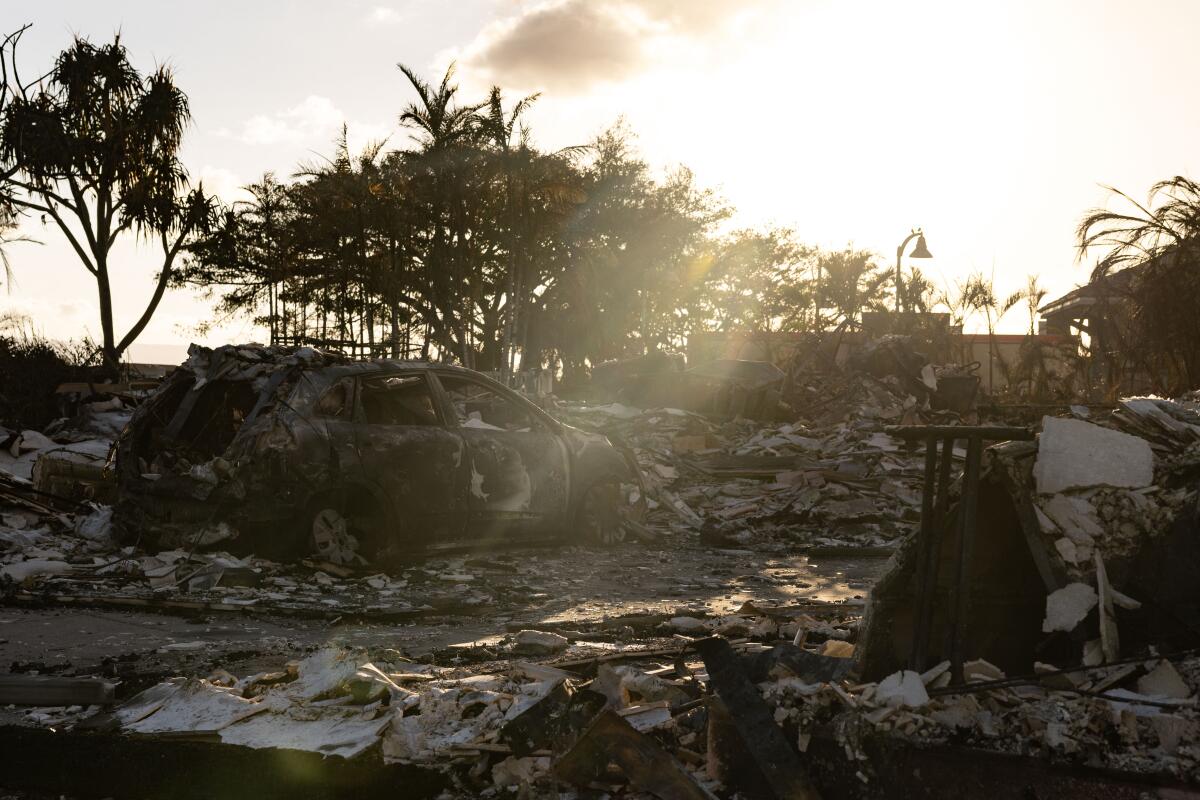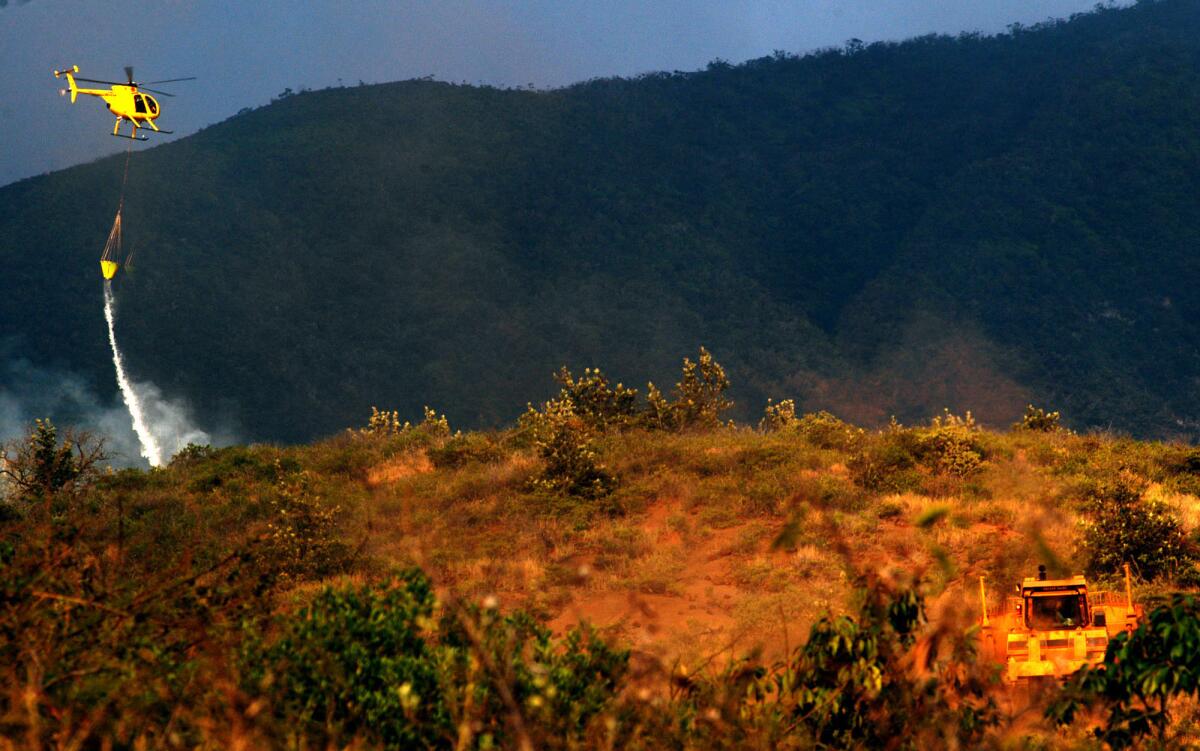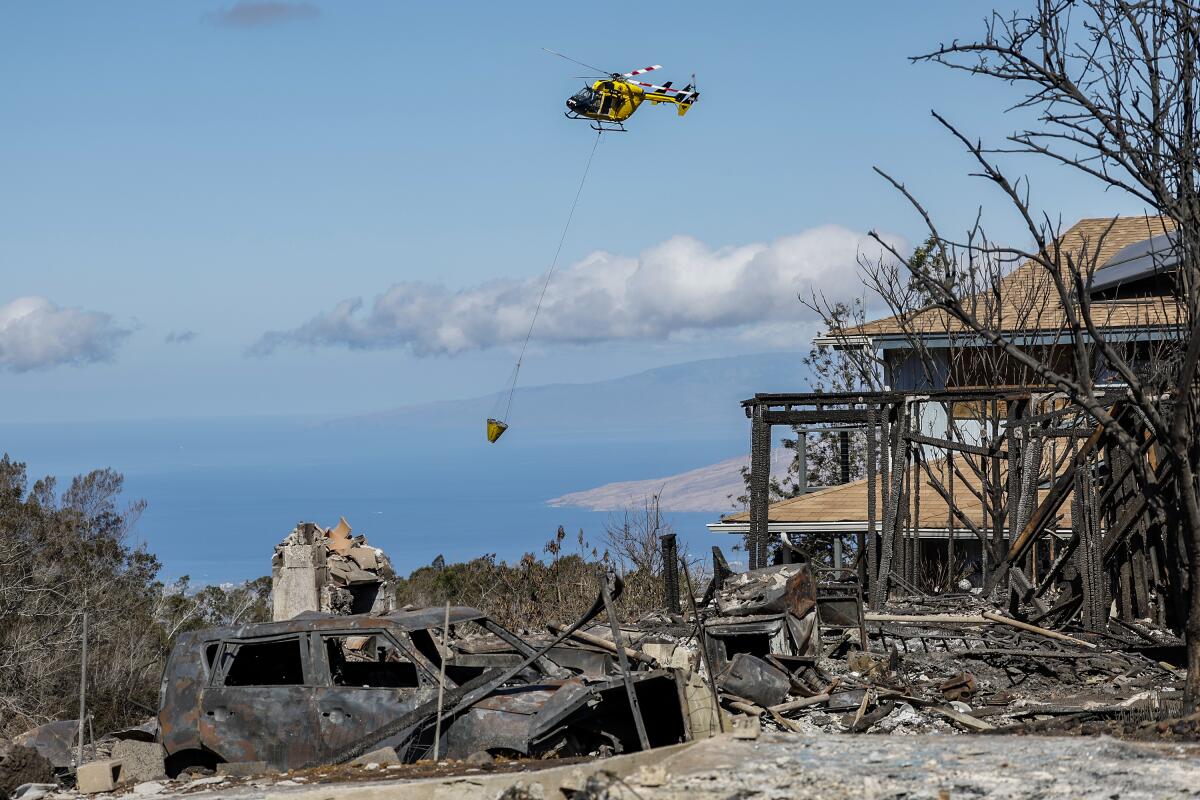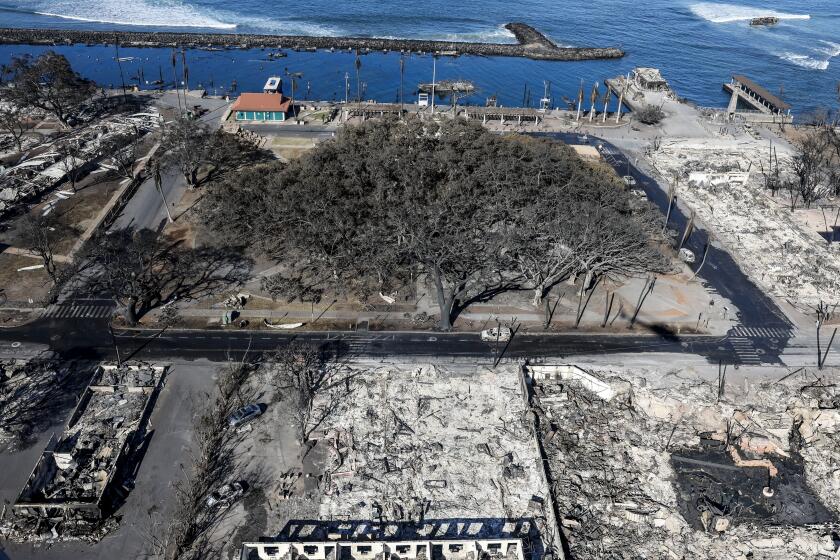Ignored warnings, hubris, slow response fueled America’s deadliest wildfire in a century

- Share via
A raging fire burning directly into densely populated areas. A historic city built between the ocean and a volcano with limited escape routes. Gale-force winds that left firefighters on the defensive.
In the wake of the deadliest U.S. wildfire in a century, officials in Hawaii have, at times, insisted that little could have been done to avoid the tragedy that obliterated a historic West Maui town and killed scores of residents.
“The largest force at play ... were 80-mph winds,” Hawaii Gov. Josh Green said last week. “We have doubts that much could have been done with a fiery, fast-moving fire like that.”
Yet there is plenty of evidence that government officials should have been aware of the danger to Lahaina, home to generations of Hawaiian families and once home of the Hawaiian king.
And what makes the wildfire all the more tragic — forever linking the town with unspeakable sorrow — is there was actually far more time to sound an alarm.
The Lahaina fire in West Maui ignited as firefighters focused on the Upcountry fire. What happened next — the deadliest U.S. wildfire in more than a century — left the historic town in ashes.
A crucial reason why the fire killed so many — at least 106 victims, and almost certainly more — is because the ignition point was in a residential neighborhood, not miles away in the wilderness.
The fire began at the town’s highest elevation, near a subdivision tucked beneath canyons that spit out howling gusts during a Santa Ana-style wind event.
The orientation of those canyons and the way the nearby neighborhoods were built in the 1970s and ’80s created a dangerous situation in the event of a wildfire.
Should homes there ignite during Santa Ana-style winds, burning embers would be blown to the southwest, acting like a fiery dagger to the heart of historic Lahaina, which has precious few escape routes.
“The ignition is probably in the worst possible spot,” said Neil Lareau, an assistant professor of atmospheric sciences at the University of Nevada-Reno. It flared in densely packed neighborhoods, providing ample fuel.
Once the homes were torched, they acted like a flammable runway as embers followed the winds downhill to the shoreline.
“In many ways, you’re creating a carpet of fuel if you’re having home-to-home propagation of fire,” UC Merced climatologist John Abatzoglou said.

Maui County officials recognized the wildfire risks — but it appears little was done to prepare, records and interviews show.
In 2018, one of the most destructive fires in state history struck West Maui, spread by similar winds.
“Wild/brush/forest fires present a growing threat to Maui County citizen safety and property. Island communities are particularly vulnerable because populations tend to be clustered and dependent on single highways, often located on the island edge,” a Maui County government commission wrote in 2021.
In fact, commissioners wrote: “Hawaii’s and Maui’s fire problem is more extreme than on the U.S. mainland.” The report they cited for that data urged attention to human-caused risks, such as above-ground power lines that can spark in windy conditions.
Here is what we know about the origin of the Maui fire and how it so rapidly became an unstoppable force that tore through Lahaina.
The Maui County Hazard Mitigation Plan warns of past windstorms, including a prior record in Maui of 83 mph. “Extreme wind is recognized as a regular occurrence in Maui County,” the report said. “All of Maui County is vulnerable to high windstorms due to the topography and movement of weather fronts through the area. During a time of extreme heat and high winds, the wildfire threat would significantly increase.”
A map of Maui in the hazard plan shows Lahaina in an area of high wildfire risk. In 2018, winds helped spread fires in the western part of the island — including in the Lahaina area — with gusts so strong that air support had to be grounded, according to a report from the Pacific Fire Exchange. Among the West Maui complex fires, 21 residences and 27 vehicles were burned.
But a lack of deaths in prior wildfires may have led to complacency among officials in Hawaii.
“You learn from your scars in emergency response,” said Tim Perry, a former chief of staff for the California Governor’s Office of Emergency Services. “If you have no scars, you may learn all at once.”

The ignition point of last week’s fire made it particularly perilous — arguably even more so than in Paradise, the Northern California town destroyed in 2018 in the state’s deadliest wildfire in modern history. Like in Lahaina, many Paradise residents never received evacuation orders, even though the Camp fire’s origin was roughly six miles away from the edge of town.
Many hours passed between the Maui fire’s first ignition and a period of quiet when fire crews deemed the blaze “100% contained.”
According to a review of Maui County’s statements made on Facebook on Aug. 8, the day the blaze began, firefighters had roughly nine hours from when the fire ignited until “an apparent flareup” that led to the destructive race toward downtown Lahaina.
Firefighters have not said what happened during that crucial span. Nor have officials explained why citywide evacuations weren’t ordered as soon as the first flames were reported in Lahaina, at 6:37 a.m., despite warnings days earlier about high fire weather danger.
Maui was suffering such severe fire weather conditions that firefighters noted, a “fire can be a mile or more from your house, but in a minute or two, it can be at your house.”

Green said Monday in a news conference that he wished officials could go back in time and have the island’s sirens sound a warning about the fire. But, he added, “typically, when sirens go off, they’re for tsunami warnings. ... They’re because we’re worried a large storm is going to come, and people historically would immediately go upcountry.”
Green said one complicating factor of warning residents was that “multiple fires” were occurring on Maui, not only the Lahaina fire.
In California, after numerous deadly fire seasons, officials have shed their reluctance to issue widespread evacuation notices amid fire weather warning signs. In 2020, Sonoma County became a model of emergency response, preparing for evacuations even before a wildfire was reported.
The Lahaina fire moved so swiftly, there aren’t many who survived. “We’re not treating more first-, second-, third-degree burns, because the fire was so perilous that it took lives — it didn’t leave survivors,” Green said in an interview with CBS News.
The blaze shares many similarities with the Oakland-Berkeley hills fire of 1991, which killed 25 people and is California’s third deadliest in modern times. The fire occurred next to a hilly wildland area, northeast of heavily populated neighborhoods with limited exit routes; firefighters thought they had it under control nearly a day before a flareup erupted.
In the 1991 blaze, fire crews were so confident they had resolved the initial fire that they left overnight. When they returned in the morning — concerned about the worst fire weather in years — they found a few hot spots, but by mid-morning, again decided they were under control. Some of the fire engines were to be sent away minutes before hot spots flared and the flames spun out of control, whipped by Diablo winds, the local name for Santa Ana winds, according to a government report by the U.S. Fire Administration.
That report questioned why an evacuation hadn’t been ordered earlier, especially given that fire weather conditions were present. The Fire Administration suggested that “most fire codes would have required an area with these fire characteristics to be evacuated. It was compared to a neighborhood with spilled gasoline flowing in the gutters.”
“Fire departments should always anticipate ‘worst case’ scenarios and develop plans and procedures to address those situations,” the report said.
Hawaii’s attorney general has launched an investigation into the overall response to Maui’s wildfire.
More to Read
Sign up for Essential California
The most important California stories and recommendations in your inbox every morning.
You may occasionally receive promotional content from the Los Angeles Times.


















